They call it “Bonin Blue.” Here I hovered, 60 feet under, surrounded in sapphire. Below, large boulders littered the sea floor. In the distance, the ocean stretched to infinity. Some divers poured across the sea floor, looking at colorful fish making refuge on the rocky bottom. I remained focused on the blue.
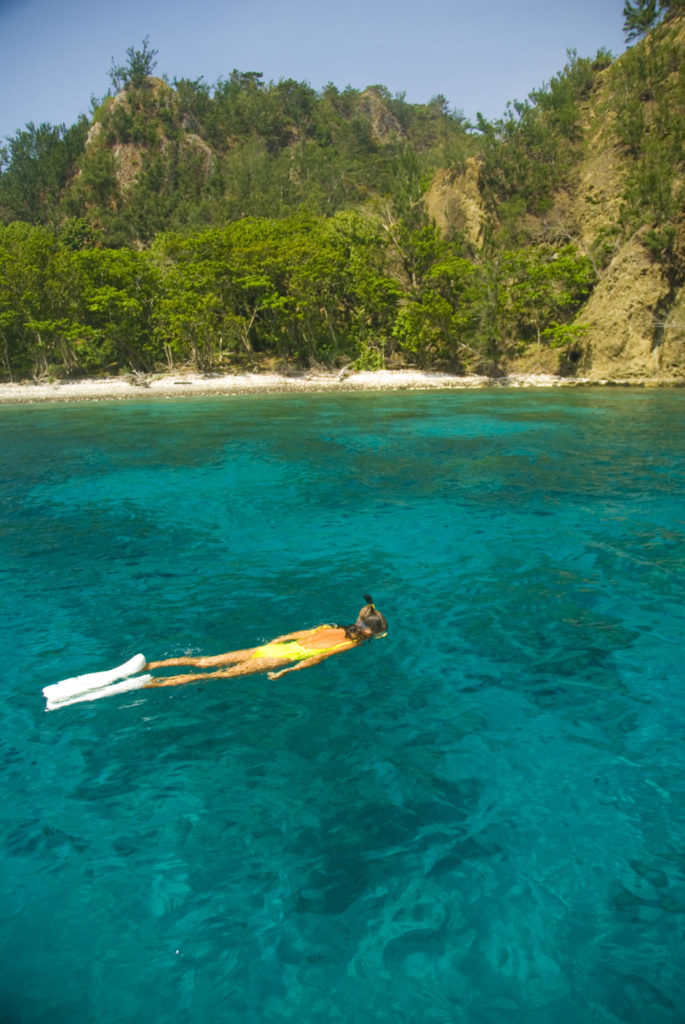
I was in the middle of nowhere, sinking beneath the waves. Naho, our effervescent dive guide, had told me just minutes before they sometimes did exploratory dives, mainly in the open water, to see what comes along. This remote place was known to have huge dogtooth tuna, wahoo and wild dolphins.
So there I hung in neutral buoyancy, immersed in gin-clear ocean, staring to see what the blue would bring. Below me was a huge marble ray resting in the sand between some boulders. Then something caught my attention out of the corner of my eye.
There was a lot of movement coming from something big. As it approached, a pod of bottlenose dolphins came into view, and they were headed right toward the divers. I adjusted my camera and strobe and prayed my big wide-angle lens dome would become an object of curiosity for these playful creatures.
I’m not sure if it was that, or my beat-up wetsuit, but to my luck they came right for me. They slowed down, came in close and took a good look as I happily flashed away. One young dolphin kept looking right at me.
Some of them had small remoras, a suckerfish that goes along for a free ride. An older dolphin had a tail with odd barnacles attached. They moved with grace and ease. It was over almost as quickly as it began; tails swaying as they disappeared off into the Bonin Blue.
That episode was enough to make me content, but when we drifted out to sea for our decompression stop, a huge wahoo came in for a look. Divers rarely see these game fish. They don’t frequent coral reefs but are found in the current lines of the open sea. This is the kind of thing you hope to see when you come to a place this remote.
The Bonin Islands (known in Japan as the Ogasawara Islands), are famous as a refuge for marine and bird wildlife. People come to see and interact with humpback whales, spinner dolphins, bottlenose dolphins, sperm whales and occasionally spotted dolphins, short-finned pilot whales, whale sharks and other pelagic.
This archipelago of 30 small rocky islands is about 1,000 kilometers south of Tokyo. Although hey aren’t too far north of the Mariana Islands, they are administered by, and officially part of, Tokyo. Only two are inhabited; Chichi-jima and Haha-jima, and of the approximately 2,300 residents, most live on Chichi-jima.
It isn’t tropical bliss here. It can actually get a bit chilly in winter. The climate is subtropical with average temperatures varying from 17.7 C (February) to 27.6 C (August).
Japan wants to try to keep the islands as pristine as possible by keeping visitor numbers low and human impact to a minimum to protect the delicate balance of wildlife found here. Although sometimes called the Galapagos of Japan, the Ogasawara chain does not have the vast diversity or history of isolation, but it is a very natural place with plenty to offer hikers, birders, WWII history buffs and those who love the sea.
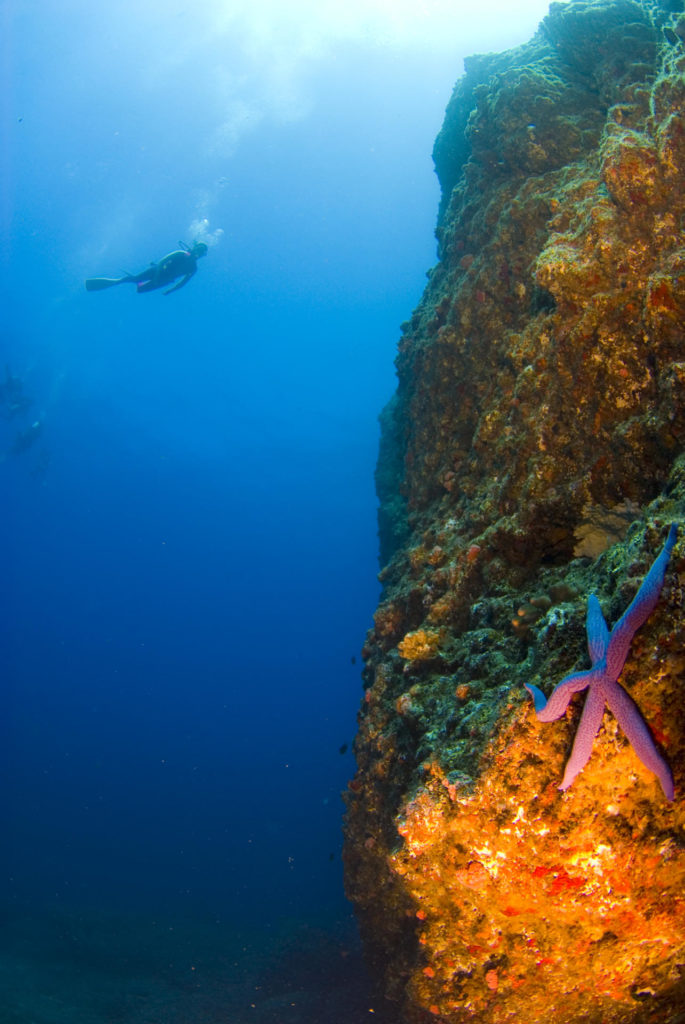
There are no airports. The only way to get there is aboard the 131-meter, 6,679-ton Ogasawara-maru from Tokyo to Chichi-jima. The 25-hour cruise departs just four to six times per month.
There are low cost group sleeping areas with communal showers all the way up to private suites. This ship also has a nice restaurant and a small lounge, upper deck outside sitting areas and entertainment centers. This overnight ride is part of the adventure, and you can meet some interesting people along the way.
One new acquaintance was Jessel Savory. Savory is a famous last name on Ogasawara, as his great, great grandfather was part of the founding fathers of the islands back in the whaling days of the 1800s.
In 1830, Savory and 24 other Euro-Americans realized the potential of supplying whaling vessels. They moved to the island and raised animals and crops and sold meat, veggies and water to whalers.
There is also an endemic tree called a savory palm after Jessel’s family. He was raised in Ogasawara, went to high school in Guam and now lives in the U.S. He was coming back with his oldest son to visit his mother who still operates a family inn on the island.
Before the settlers, the islands were virtually uninhabited. Ancient settlers had been long gone, so the history here is relatively short, yet colorful. Aside from the whaling history, this is the place during WWII where former U.S. president George H.W. Bush was shot down. He was rescued, but his crew was taken captive and never made it home.
One big draw is whale watching. This port, once chock full of whalers and pirates, now attracts whale lovers. “I don’t understand our government,” one Japanese man told me, referring to Japan’s constant quest to resume whale hunting.
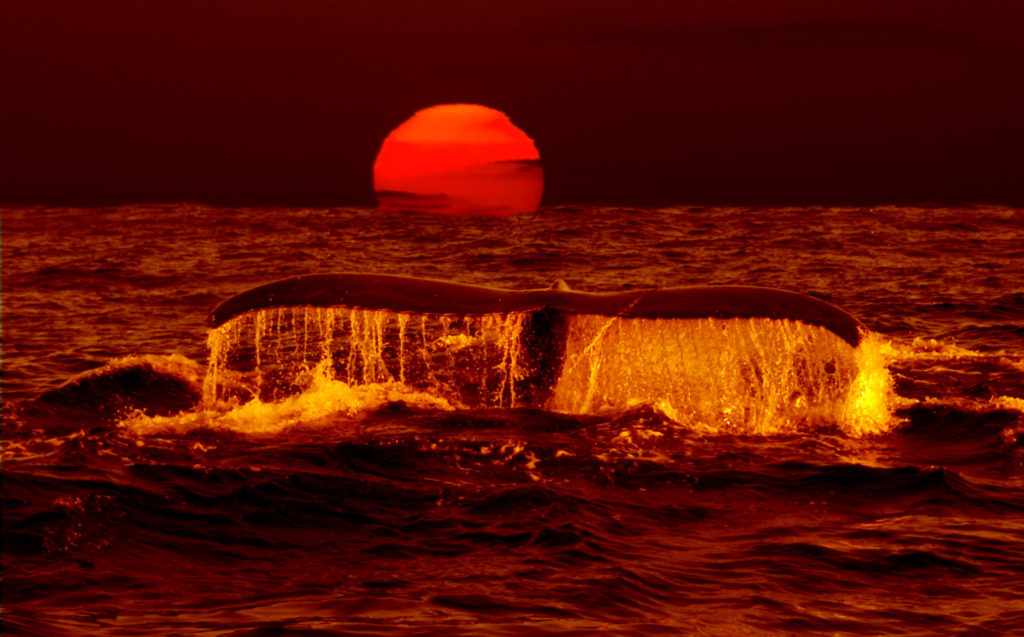
“Most people don’t want to see whale hunting anymore. We just like to watch them play.” For many years, whales actually avoided the place. Whether it had to do with past hunting or the one-time low numbers of whales worldwide, no one knows. Nonetheless, humpback whales and sperm whales have now been coming back in good numbers.
In whale season, the humpback whale watchers in boats around Ogasawara boast a daily 90 percent success rate for seeing humpbacks. Sperm whales also frequent these waters.
Chichi-jima has some nice lookouts from well-maintained trails to the west from where you can see whales. Just bring high-powered binoculars. The island also has some tougher hikes that can take a couple of hours both ways through goat trails. But the reward is an isolated beach with powdered sugar-like sand.
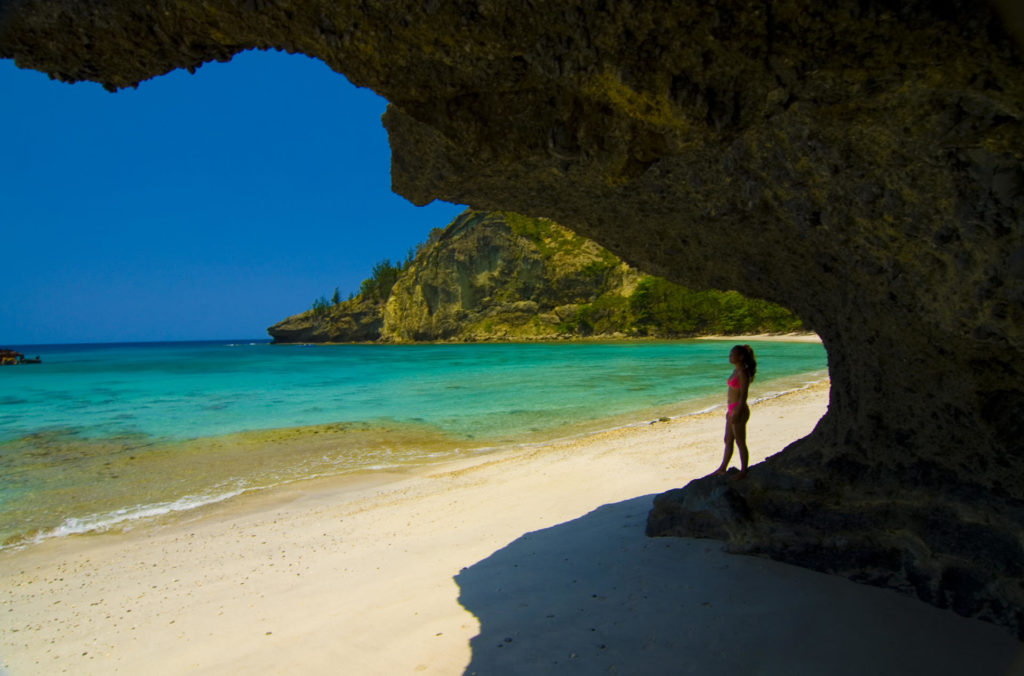
We combined searching for dolphins and whale watching with diving. You can get in two, or even three, dives in a full day. Between dives you can enjoy a snack or lunch while the captain and crew look for whales and dolphins.
Like the savory palm, there are some unusual things to see underwater as well. The Ogasawara butterfly fish (Chaetodon daedalma) is a stunning little fish found only in these waters. We saw them in pairs and small schools along the rocky undersea terrain of the islands.
While most of the terrain is rocky and not very colorful, there are current fed passes with thick growths of healthy corals. You can have a wild time drift snorkeling in the passes in three-to-five-knot currents. The reef rushes by, and you barely have to kick a fin.
The impressive underwater world features huge boulders tumbling down to the depths. These form small caves that hold seasonal visitors with a scary array of teeth. Sand tiger sharks prefer these refuges and can be seen at 20-to-35-meter depths in many of the known shelters. While their toothy grin is alarming, they are normally shy and not aggressive.
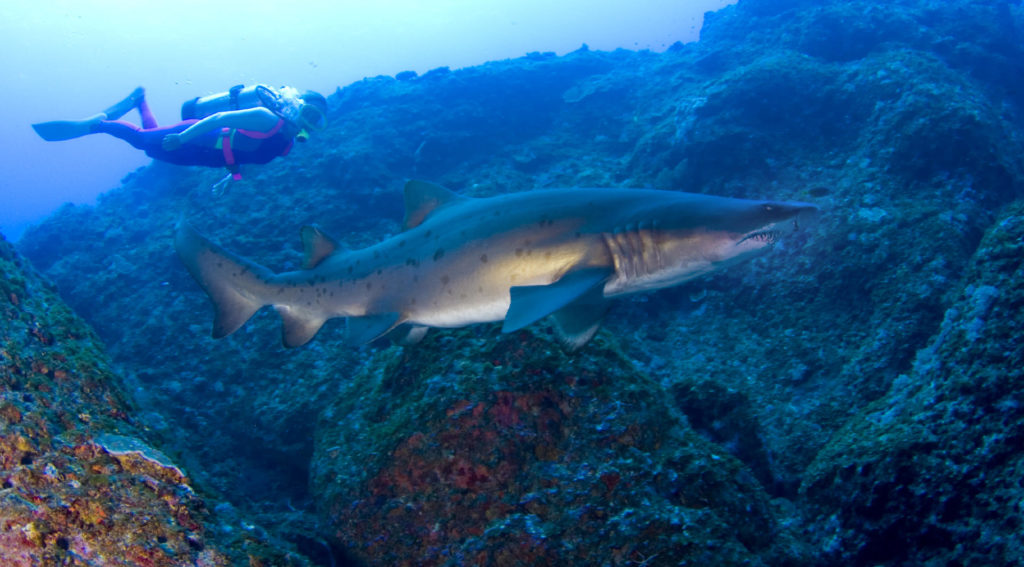
Some of the best diving is done farther up the chain at islands that are big, rocky and rough and have no one living there. Muko-jima holds some surprises. A couple of the natural arches are the haunts of hundreds of immense dogtooth tuna.
You can swim in and stay off to the side of these stunning arches. Breathe lightly and the tuna will drift in close. Some are as large as the divers watching them. There are few places in the world where divers can approach congregations like this.
While we were enjoying the diving and the added bonus of seeing both humpbacks and sperm whales between dives, our main reason for coming here was dolphins. Bottlenose dolphins don’t seem to mind humans. Sometimes they swim right by, but they usually get curious, playful and downright acrobatic.
It is for these moments you spend days at sea looking for them and jumping into the water. The encounters are normally brief and wild, with dolphins swimming at you, under you and circling around.
We spent a couple of days with some local divers who seemed part dolphin themselves. They would swim down 10-15 meters and mimic the dolphin movements. Sometimes the dolphins would go for it, and chaos ensued with lots of play and tricks.
Perhaps our best encounter came while the locals were off gathering some octopus after the morning after a full moon. When they went ashore to reef walk looking for fresh taco, we went off in search of a pod. Sure enough, a small group appeared, and they were relaxed and curious.
They would swim right with us, their tails coming within centimeters of actually touching my wide-angle lens. We were able to hang with this pod for a nice long swim, bobbing down with them as they moved slowly along the sea floor and then playing at the surface when they came up for a breath.
The rays of the sun created shafts of light filtering up from the stunning clear blue of the sea. It was a bit of magic.
A day at sea is usually an eight-hour trip and June through October is the best season, but they are around all year. Sperm whale watching is best from spring to late autumn, with August to October the best season. This is the place where National Geographic sponsored the scientists who recently took the first ever photos of giant squid, the favorite food of sperm whales.
War buffs can also explore the many caves and old guns and artifacts still in the hills. Snorkelers and divers can go out to see the WWII wreck Hinko Maru. It was hit by an enemy submarine torpedo and hauled into the Sakai Ura Bay area. It is now crumpled, but a great refuge for fish. Visibility is best at high tide for shallow dives or snorkels here.
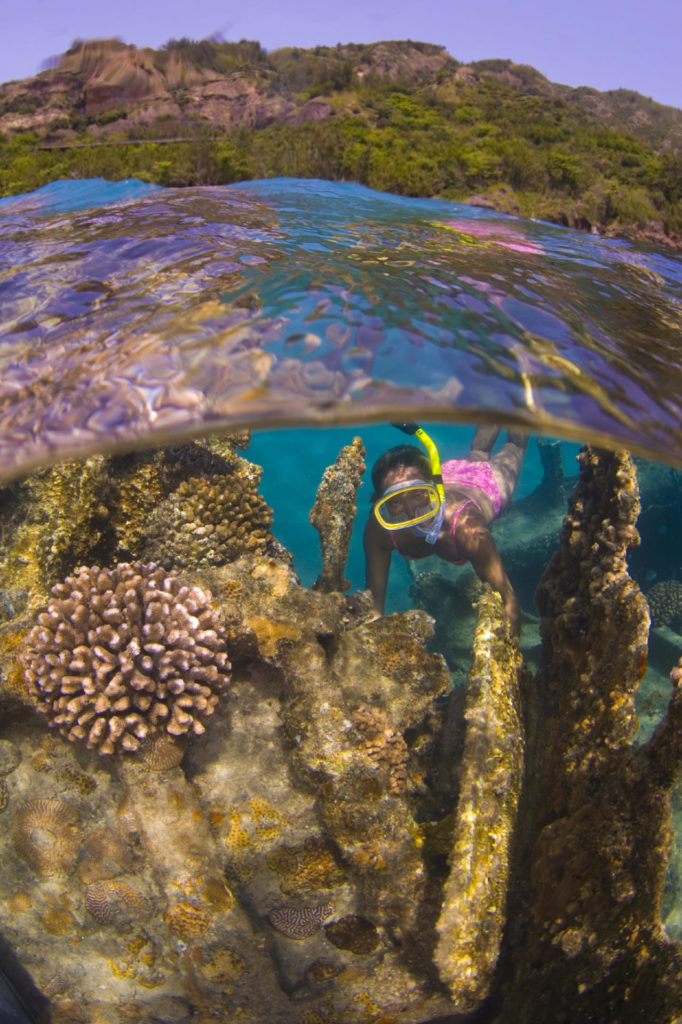
The island’s town has a nice selection of small eateries and pubs. The stores have some Ogasawara products such as sea salt and amberjack sushi. There are museums and whale info centers. Gift shops offer souvenirs carved from whalebone. At night, you can take a hike looking for fluorescent mushrooms and fruit bats.
It’s a fascinating little place that few visit, but those who do never forget the magic of Bonin Blue.
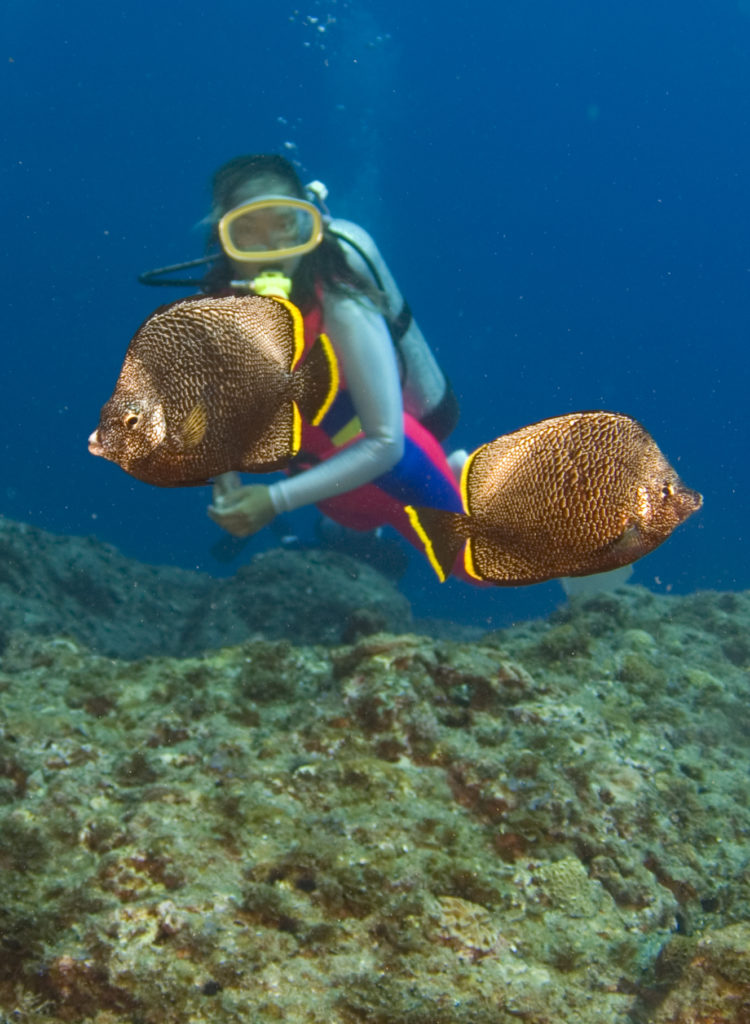
TRAVEL NOTES
Getting There: There is only one way to get to the Bonin Islands unless you own your own ship or sailboat. The Ogasawara Maru is not cheap; prices range from ¥22,500 to ¥55,000 one way, depending on the level of comfort you require. Tel: (03) 3451-5171.
Places to Stay: There are 42 inns on Chichi-jima and 12 on Haha-jima, costing about ¥6,500 – ¥10,000 per person with two meals. For general tourism information, contact: the Ogasawara Tourist Association. It is good to speak and read some Japanese, as there isn’t much in English, but you can get by if need be. Tel: (04998) 2-2587
MARINE LIFE
The best time to see marine life is late spring through early fall, although the humpbacks come in winter. Many fish are spawning in August and September as well.
Humpback whales: January – April.
Spinner dolphins & bottlenose dolphins: Through the year but June through October is best. The water is warmer.
Sperm whales: Mainly summer through autumn.
Sand tiger sharks and spiny lobster: May through September.
Sea turtles: March through September.
Dogtooth tuna: May through September.
For more information, contact the Ogasawara Whale Watching Association. Tel: (04998)-2-3215.




